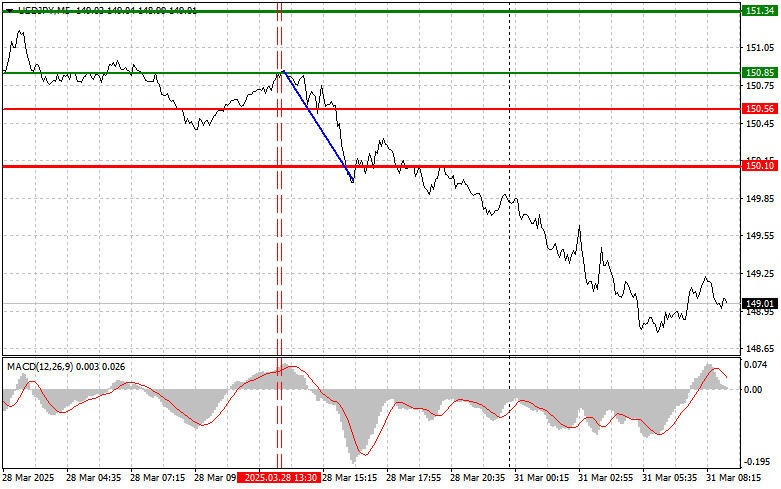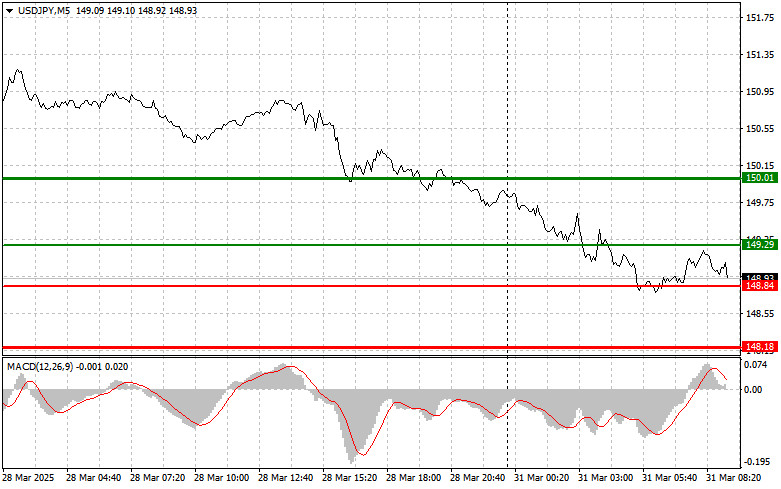Analysis of Trades and Trading Tips for the Japanese Yen
The price test at 150.85 occurred when the MACD indicator had already moved significantly above the zero level, limiting the pair's upside potential. For this reason, I did not buy the dollar. Shortly after, another test of 150.85 while the MACD was in the overbought zone triggered Sell Scenario #2, which led to a drop in the pair by more than 70 pips.
Today's strong data on Japan's industrial production growth supported the yen and put additional pressure on the dollar. Output increased by 2.5%, compared to the expected 1.9%. This unexpected rise signals a recovery of the Japanese economy following recent challenges. Increased production—especially in key sectors like the auto and electronics industries—brings optimism about Japan's economic outlook. The yen's appreciation against the dollar reflects growing investor confidence in the Japanese currency, which was traditionally seen as a safe haven during economic uncertainty. Additional pressure on the dollar also stems from expectations that the Bank of Japan might continue raising interest rates, especially given the improvement in economic indicators.
Japan's retail sales data also came out quite strong. Contrary to analysts' concerns of a decline, the indicator showed a confident rise, signaling a recovery in consumer demand. This is a positive sign for the Japanese economy, which has long struggled with deflation and weak growth. While it's too early to declare a full recovery, the positive retail momentum gives hope for further improvement.
For intraday strategy, I will focus primarily on implementing Scenarios #1 and #2.
Buy Signal
Scenario #1: I plan to buy USD/JPY today at the 149.29 entry point (green line on the chart), targeting a rise to 150.01 (thicker green line). Around 150.01, I plan to exit the long position and open a short position in the opposite direction (aiming for a 30–35 pip retracement). It's best to re-enter long positions after corrections and significant dips in USD/JPY. Important: Before buying, make sure the MACD indicator is above the zero level and just beginning to rise.
Scenario #2: I also plan to buy USD/JPY if the price tests 148.84 twice while the MACD is in the oversold zone. This would limit the pair's downside potential and lead to an upward reversal. A rise toward 149.29 and 150.01 can be expected.
Sell Signal
Scenario #1: I plan to sell USD/JPY only after breaking below 148.84 (red line on the chart), which would lead to a quick decline. The main target for sellers will be 148.18, where I plan to exit the short position and open a long one (aiming for a 20–25 pip retracement). Selling pressure could return at any moment. Important: Before selling, ensure the MACD indicator is below zero and beginning to fall.
Scenario #2: I also plan to sell USD/JPY today if the price tests 149.29 twice while the MACD is in the overbought zone. This would limit the pair's upside potential and lead to a downward reversal. A decline toward 148.84 and 148.18 can be expected.
What's on the Chart:
- The thin green line represents the entry price where the trading instrument can be bought.
- The thick green line indicates the expected price level where a Take Profit order can be placed, or profits can be manually secured, as further price growth above this level is unlikely.
- The thin red line represents the entry price where the trading instrument can be sold.
- The thick red line indicates the expected price level where a Take Profit order can be placed, or profits can be manually secured, as further price decline below this level is unlikely.
- The MACD indicator should be used to assess overbought and oversold zones when entering the market.
Important Notes:
- Beginner Forex traders should exercise extreme caution when making market entry decisions. It is advisable to stay out of the market before the release of important fundamental reports to avoid exposure to sharp price fluctuations. If you choose to trade during news releases, always use stop-loss orders to minimize potential losses. Trading without stop-loss orders can quickly wipe out your entire deposit, especially if you neglect money management principles and trade with high volumes.
- Remember, successful trading requires a well-defined trading plan, similar to the one outlined above. Making impulsive trading decisions based on the current market situation is a losing strategy for intraday traders.














